

The hammerhead turn, stall turn, or Fieseler is an aerobatics turn-around maneuver.


The hammerhead turn, stall turn, or Fieseler is an aerobatics turn-around maneuver.
Enter at full power and maximum airspeed. Pull the aircraft up through a quarter loop into a vertical climb. The speed will decay but before upward motion stops firmly apply full rudder to yaw the aircraft through a cartwheel of 180° until the nose is straight down. Dive vertically to the same altitude as the maneuver started, then pull out, exiting in the opposite direction. [1]
The timing of applying full rudder is critical. If instigated too soon it results in a wingover. If instigated too late the plane will fall into a sideslip or else enter a tailslide which most aircraft are restricted from doing.
Performing the pivot requires sufficient airflow over the rudder. In planes with a suitably-positioned propeller, the propwash may provide this. Otherwise, rudder must be applied sooner while the plane still has forward airspeed. [2]
This maneuver demands there be no rolling at all but when airflow is minimal ailerons become ineffective. So as soon as the yaw is established reduce throttle to prevent the aircraft from rolling due to engine torque. Do not open the throttle again until the dive when sufficient airspeed has been gained for aileron control. [1] Reduced throttle will also prevent gyroscopic precession from pitching the nose up.
Higher lift from the faster moving outside right wing will roll the airplane to the left. To maintain attitude in addition to left rudder, holding forward right stick necessary throughout the pivot. [2] Depending on the direction of the turn, the opposite may apply.
This maneuver has also been called the search and rescue reversal. SAR helicopters fly this when hunting survivors or submarines, because it brings the aircraft directly back along the same course to verify the target. The maneuver doesn't require visual meteorological conditions (VMC) if the pilot is proficient at maintaining altitude by keeping the lateral acceleration ball centered, as any uncoordinated lateral acceleration will induce spatial disorientation.[ citation needed ]

An aileron is a hinged flight control surface usually forming part of the trailing edge of each wing of a fixed-wing aircraft. Ailerons are used in pairs to control the aircraft in roll, which normally results in a change in flight path due to the tilting of the lift vector. Movement around this axis is called 'rolling' or 'banking'.

In flight dynamics a spin is a special category of stall resulting in autorotation about the aircraft's longitudinal axis and a shallow, rotating, downward path approximately centred on a vertical axis. Spins can be entered intentionally or unintentionally, from any flight attitude if the aircraft has sufficient yaw while at the stall point. In a normal spin, the wing on the inside of the turn stalls while the outside wing remains flying. It is possible for both wings to stall, but the angle of attack of each wing, and consequently its lift and drag, are different.

Aircraft flight control surfaces are aerodynamic devices allowing a pilot to adjust and control the aircraft's flight attitude.

A slip is an aerodynamic state where an aircraft is moving somewhat sideways as well as forward relative to the oncoming airflow or relative wind. In other words, for a conventional aircraft, the nose will be pointing in the opposite direction to the bank of the wing(s). The aircraft is not in coordinated flight and therefore is flying inefficiently.

Dutch roll is an aircraft motion consisting of an out-of-phase combination of "tail-wagging" (yaw) and rocking from side to side (roll). This yaw-roll coupling is one of the basic flight dynamic modes. This motion is normally well damped in most light aircraft, though some aircraft with well-damped Dutch roll modes can experience a degradation in damping as airspeed decreases and altitude increases. Dutch roll stability can be artificially increased by the installation of a yaw damper. Wings placed well above the center of gravity, sweepback and dihedral wings tend to increase the roll restoring force, and therefore increase the Dutch roll tendencies; this is why high-winged aircraft often are slightly anhedral, and transport-category swept-wing aircraft are equipped with yaw dampers. A similar phenomenon can happen in a trailer pulled by a car.

Aerobatic maneuvers are flight paths putting aircraft in unusual attitudes, in air shows, dogfights or competition aerobatics. Aerobatics can be performed by a single aircraft or in formation with several others. Nearly all aircraft are capable of performing aerobatics maneuvers of some kind, although it may not be legal or safe to do so in certain aircraft.
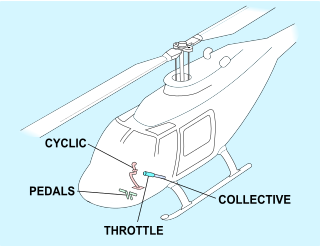
Helicopter flight controls are used to achieve and maintain controlled aerodynamic helicopter flight. Changes to the aircraft flight control system transmit mechanically to the rotor, producing aerodynamic effects on the rotor blades that make the helicopter move in a desired way. To tilt forward and back (pitch) or sideways (roll) requires that the controls alter the angle of attack of the main rotor blades cyclically during rotation, creating differing amounts of lift at different points in the cycle. To increase or decrease overall lift requires that the controls alter the angle of attack for all blades collectively by equal amounts at the same time, resulting in ascent, descent, acceleration and deceleration.
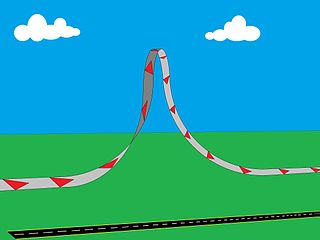
A barrel roll is an aerial maneuver in which an airplane makes a complete rotation on both its longitudinal and lateral axes, causing it to follow a helical path, approximately maintaining its original direction. It is sometimes described as a "combination of a loop and a roll". The g-force is kept positive on the object throughout the maneuver, commonly between 2 and 3g, and no less than 0.5g. The barrel roll is commonly confused with an aileron roll.

In a straight flight, the tail of the airplane aligns the fuselage into the relative wind. However, in the beginning of a turn, when the ailerons are being applied in order to bank the airplane, the ailerons also cause an adverse yaw of the airplane. For example, if the airplane is rolling clockwise, the airplane yaws to the left. It assumes a crab-like attitude relative to the wind. This is called a slip. The air is flowing crosswise over the fuselage. In order to correct this adverse slip, the pilot must apply rudder. If the pilot applies too much rudder, the airplane will then slip to the other side. This is called a skid.
The dynamic stability of an aircraft refers to how the aircraft behaves after it has been disturbed following steady non-oscillating flight.
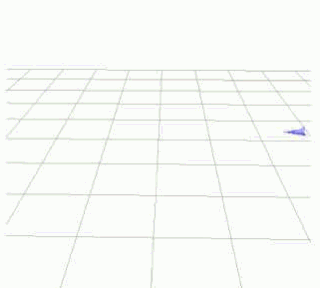
The term Immelmann turn, named after German World War I Eindecker fighter ace Leutnant Max Immelmann, refers to two different aircraft maneuvers. In World War I aerial combat, an Immelmann turn was a maneuver used after an attack on another aircraft to reposition the attacking aircraft for another attack. In modern aerobatics, an Immelmann turn is an aerobatic maneuver that results in level flight in the opposite direction at a higher altitude.
A Lomcovák is a family of extreme aerobatic maneuvers where the aircraft, with almost no forward speed, rotates on chosen axes due to the gyroscopic precession and torque of the rotating propeller.
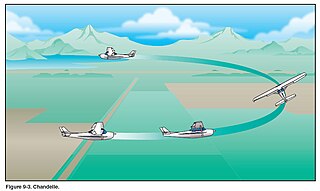
The chandelle is an aircraft control maneuver where the pilot combines a 180° turn with a climb.
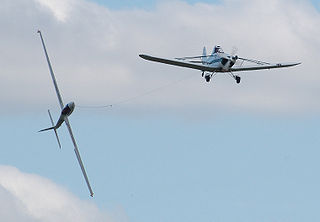
The aileron roll is an aerobatic maneuver in which an aircraft does a full 360° revolution about its longitudinal axis. When executed properly, there is no appreciable change in altitude and the aircraft exits the maneuver on the same heading as it entered. This is commonly one of the first maneuvers taught in basic aerobatics courses. The aileron roll is commonly confused with a barrel roll.
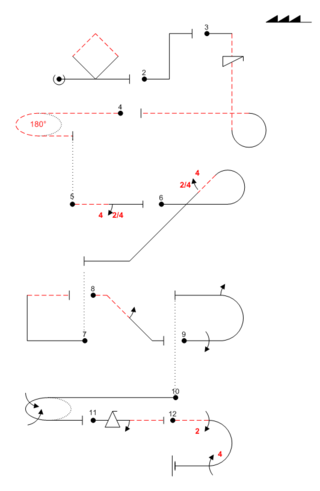
Radio-controlled aerobatics is the practice of flying radio-controlled aircraft in maneuvers involving aircraft attitudes that are not used in normal flight.
Supermaneuverability is the capability of fighter aircraft to execute tactical maneuvers that are not possible with purely aerodynamic techniques. Such maneuvers can involve controlled side-slipping or angles of attack beyond maximum lift.
3D Aerobatics or 3D flying is a form of flying using flying aircraft to perform specific aerial maneuvers. They are usually performed when the aircraft had been intentionally placed in a stalled position for purposes of entertainment or display. They are also often referred to as post-stall maneuvers, as they occur after aerodynamic stall has occurred and standard control surface deflections, as used in flight, are not effective.
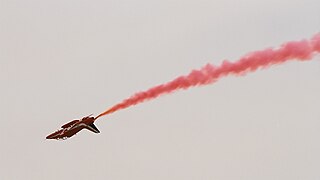
A slow roll is a roll made by an airplane, in which the plane makes a complete rotation around its roll axis while keeping the aircraft flying a straight and level flightpath. A slow roll is performed more slowly than an aileron roll; although it is not necessarily performed very slowly, it is performed slowly enough to allow the pilot to maintain balance, keeping a steady flightpath, pitch angle, and height (altitude) throughout the maneuver. The maneuver is performed by rolling the airplane at a controlled rate with the ailerons, and moving the elevators and rudder in opposition, or "cross-controlling," to keep the plane on a steady, level flightpath.
A wingover is an aerobatic maneuver in which an airplane makes a steep climb, followed by a vertical flat-turn. The maneuver ends with a short dive as the plane gently levels out, flying in the opposite direction from which the maneuver began.

A falling leaf is a maneuver in which an aircraft performs a wings-level stall which begins to induce a spin. This spin is countered with the rudder, which begins a spin in the opposite direction that must be countered with rudder, and the process is repeated as many times as the pilot determines. During the maneuver, the plane resembles a leaf falling from the sky; first slipping to one side, stopping, and then slipping to the other direction; continuing a side-to-side motion as it drifts toward the ground.